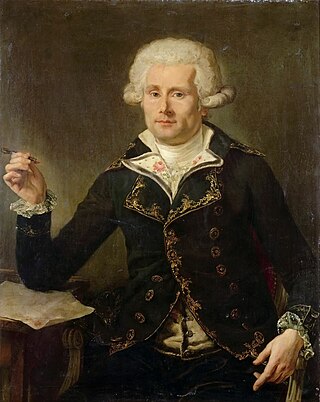
Louis-Antoine, Comte de Bougainville was a French admiral and explorer. A contemporary of the British explorer James Cook, he took part in the Seven Years' War in North America and the American Revolutionary War against Britain. Bougainville later gained fame for his expeditions, including a circumnavigation of the globe in a scientific expedition in 1763, the first recorded settlement on the Falkland Islands, and voyages into the Pacific Ocean. Bougainville Island of Papua New Guinea as well as the Bougainvillea flower are named after him.

Jeanne Baret was a member of Louis Antoine de Bougainville's expedition on the ships La Boudeuse and Étoile in 1766–1769. Baret is recognized as the first woman to have completed a voyage of circumnavigation of the globe, which she did via maritime transport.
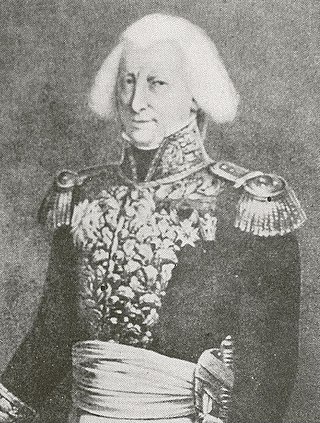
Claude-Henri Belgrand de Vaubois was a French general during the French Revolutionary Wars and the Napoleonic Wars. He is best known for the surrender of Malta to the British in 1800. On 20 August 1808 he was created Comte de Belgrand de Vaubois. Later, his name was inscribed on the Arc de Triomphe in Paris.

Jean-Baptiste Perrée was a French Navy officer and Rear-admiral.

HMS Dolphin was a 24-gun sixth-rate frigate of the Royal Navy. Launched in 1751, she was used as a survey ship from 1764 and made two circumnavigations of the world under the successive commands of John Byron and Samuel Wallis. She was the first ship to circumnavigate the world twice. She remained in service until she was paid off in September 1776. She was broken up in early 1777.

HMS Latona was a 36-gun, fifth-rate frigate of the Royal Navy that served during the American Revolutionary War, the French Revolutionary Wars, and the Napoleonic Wars. Shortly after her launch in 1781, she participated in the Battle of Dogger Bank against a Dutch squadron in the North Sea. In September 1782, Latona took part in the relief of Gibraltar and was the first ship in the convoy to pass through the Straits, when Richard Howe sent her ahead, to spy on the condition of the Franco-Spanish fleet in Algeciras Bay.

Count Honoré Joseph Antoine Ganteaume was a French Navy officer and Vice-admiral.
Étoile ("Star") was a fluyt of the French Navy. She was originally a merchantman named Placelière and was purchased by the Navy while still on the stocks. She was renamed Étoile in April 1763 and re-classed as a corvette. She is famous for being one of Louis Antoine de Bougainville's ships in his circumnavigation between 1766 and 1769, along with Boudeuse.
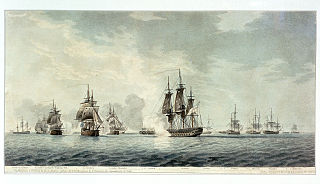
Courageuse was a 40-gun Virginie-class frigate of the French Navy, completed in 1794 and renamed Justice in April 1795. The British and Ottomans captured her in 1801 at the siege of Alexandria and she became a prize to the Ottomans.
Eleven ships of the Royal Navy have borne the name HMS Weazel or HMS Weazle, archaic spellings of weasel, while another was planned:

The siege of Malta, also known as the siege of Valletta or the French blockade, was a two-year siege and blockade of the French garrison in Valletta and the Three Cities, the largest settlements and main port on the Mediterranean island of Malta, between 1798 and 1800. Malta had been captured by a French expeditionary force during the Mediterranean campaign of 1798, and garrisoned with 3,000 soldiers under the command of Claude-Henri Belgrand de Vaubois. After the British Royal Navy destroyed the French Mediterranean Fleet at the Battle of the Nile on 1 August 1798, the British were able to initiate a blockade of Malta, assisted by an uprising among the native Maltese population against French rule. After its retreat to Valletta, the French garrison faced severe food shortages, exacerbated by the effectiveness of the British blockade. Although small quantities of supplies arrived in early 1799, there was no further traffic until early 1800, by which time starvation and disease were having a disastrous effect on the health, morale, and combat capability of the French troops.
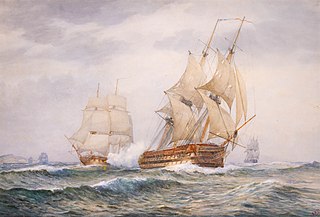
The Battle of the Malta Convoy was a naval engagement of the French Revolutionary Wars fought on 18 February 1800 during the Siege of Malta. The French garrison at the city of Valletta in Malta had been under siege for eighteen months, blockaded on the landward side by a combined force of British, Portuguese. and irregular Maltese forces and from the sea by a Royal Navy squadron under the overall command of Lord Nelson from his base at Palermo on Sicily. In February 1800, the Neapolitan government replaced the Portuguese troops with their own forces and the soldiers were convoyed to Malta by Nelson and Lord Keith, arriving on 17 February. The French garrison was by early 1800 suffering from severe food shortages, and in a desperate effort to retain the garrison's effectiveness a convoy was arranged at Toulon, carrying food, armaments and reinforcements for Valletta under Contre-amiral Jean-Baptiste Perrée. On 17 February, the French convoy approached Malta from the southeast, hoping to pass along the shoreline and evade the British blockade squadron.
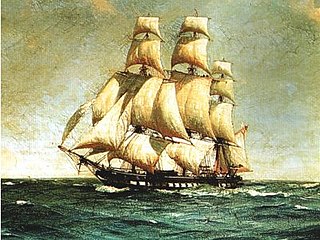
Alceste was a Magicienne class frigate of the French Navy, launched in 1780, that the British seized at the Siege of Toulon. They transferred her to the Kingdom of Sardinia, but the French recaptured her a year later in the action of 8 June 1794. The British captured her again at the action of 18 June 1799 and took her into service as HMS Alceste. In 1801 she became a floating battery and she was sold the next year.
The French brig Alerte was launched in April 1787. The Royal Navy captured her at Toulon in August 1793, and renamed her HMS Vigilante. The British set her on fire when they evacuated Toulon in December of that year. After the French rebuilt her as Alerte, she served at the Battle of Aboukir Bay. The British recaptured her in June 1799 and took her into service as HMS Minorca. Minorca was sold in 1802.
The Croisière de Bruix was the principal naval campaign of the year 1799 during the French Revolutionary Wars. The expedition began in April 1799 when the bulk of the French Atlantic Fleet under Vice-Admiral Étienne Eustache Bruix departed the base at Brest, evading the British Channel Fleet which was blockading the port and tricking the commander Admiral Lord Bridport into believing their true destination was Ireland. Passing southwards, the French fleet narrowly missed joining with an allied Spanish Navy squadron at Ferrol and was prevented by an easterly gale from uniting with the main Spanish fleet at Cádiz before entering the Mediterranean Sea. The Mediterranean was under British control following the destruction of the French Mediterranean Fleet at the Battle of the Nile in August 1798, and a British fleet nominally under Admiral Earl St Vincent was stationed there. Due however to St. Vincent's ill-health, operational control rested with Vice-Admiral Lord Keith. As Keith sought to chase down the French, the Spanish fleet followed Bruix into the Mediterranean before being badly damaged in a gale and sheltering in Cartagena.
The action of 18 June 1799 was a naval engagement of the French Revolutionary Wars fought off Toulon in the wake of the Mediterranean campaign of 1798. A frigate squadron under Rear-admiral Perrée, returning to Toulon from Syria, met a 30-ship British fleet under Lord Keith. Three ships of the line and two frigates detached from the British squadron, and a 28-hour running battle ensued. When the British ships overhauled them, the French frigates and brigs had no choice but to surrender, given their opponents' overwhelming strength.

HMS Vincejo, was the Spanish naval brig Vencejo, which was built c.1797, probably at Port Mahon, and that the British captured in 1799. The Royal Navy took her into service and she served in the Mediterranean where she captured a privateer and a French naval brig during the French Revolutionary Wars. After the start of the Napoleonic Wars, the French captured Vencejo in Quiberon Bay in 1804. The French Navy took her into service as Victorine, but then sold her in January 1805. She then served as the French privateer Comte de Regnaud until the British recaptured her in 1810. The Royal Navy did not take her back into service.
HMS Weazel or Weazle was a 16-gun ship-sloop of the Royal Navy, in active service during the War of the Austrian Succession, the Seven Years' War and the American Revolutionary War. Launched in 1745, she remained in British service until 1779 and captured a total of 11 enemy vessels. She was also present, but not actively engaged, at the Second Battle of Cape Finisterre in 1747.

Martin's cruise of 1794 was the only significant French naval operation of the year in the Mediterranean Sea. In 1793 France had gone to war with Great Britain and a wide coalition of European enemies in the French Revolutionary Wars. Early in the conflict the British had seized the French Mediterranean Fleet and their home port of Toulon, the town enduring a four month siege by French Republican forces in which the fleet was badly damaged. With the town and fleet back in French hands, the French set about effecting repairs as the British attacked the island of Corsica.

HMS Swallow was a 14-gun Merlin-class sloop of the Royal Navy. Commissioned in 1745, she initially served in home waters as a convoy escort and cruiser before sailing to join the East Indies Station in 1747. There she served in the squadron of Rear-Admiral Edward Boscawen, taking part in an aborted invasion of Mauritius and the Siege of Pondicherry. In 1755 Swallow returned home to join the Downs Station, as part of which she fought at the Raid on St Malo, Raid on Cherbourg, and Battle of Saint Cast in 1758. She was also present when the French fleet broke out of Brest prior to the Battle of Quiberon Bay in 1759.














